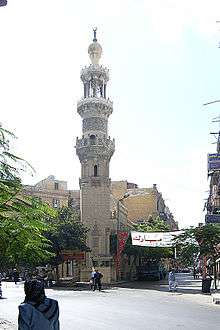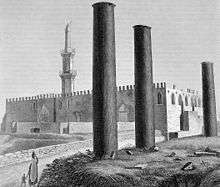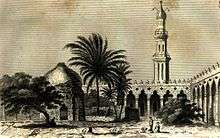Attarine Mosque
The Attarine Mosque (Arabic: مسجد العطارين) also known as the Mosque of St. Athanasius or the Mosque of a Thousand Columns was a Catholic Church-turned mosque that is situated in the Attarine District in Alexandria, Egypt. The former church was built in 370 AD and is dedicated to St. Athanasius of Alexandria. When Islam came to Egypt, the church was converted to a small mosque. [1]
| Attarine Mosque | |
|---|---|
مسجد العطارين | |
 | |
| Religion | |
| Affiliation | Sunni Islam |
| Location | |
| Location | Alexandria, Egypt |
 Egypt | |
| Geographic coordinates | 31.191902°N 29.900004°E |
| Architecture | |
| Type | Mosque |
| Date established | 641 (as mosque) |
| Completed | 370 |
Roman rule
In 370 AD, The Church of St. Athanasius was built.
Islamic conquest

On November 8, 641 AD, Alexandria fell into Muslim control by the caliph, Umar after a 14-month siege under the leadership of Amr ibn al-As when the Byzantine Empire surrendered the city and a treaty was signed. Since then, the church was turned into a mosque by the Muslims.
Napoleonic expedition

In 1798, Napoleon Bonaparte led the French campaign in Egypt and Syria. The Attarine Mosque was once thought by the French to house the Tomb of Alexander the Great. Vivant Denon's drawing of the mosque courtyard depicted a small octagonal building housing a sarcophagus closely resembling the "House of Alexander the Great" which leads to speculations whether this was the tomb of the city's founder. It was later known that the sarcophagus belongs to Nectanebo II.[2][3]
References
- "The Attarine Mosque in Alexandria, Egypt". www.touregypt.net (in Russian). Retrieved 2018-04-08.
- "Sarcophagus of Nectanebo II – Google Arts & Culture". Google Cultural Institute. Retrieved 2018-04-08.
- Chugg, Andrew (2012-06-01). The Quest for the Tomb of Alexander the Great (Second Edition). Lulu.com. ISBN 9780955679063.